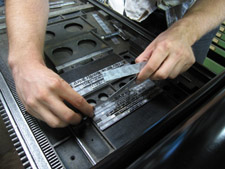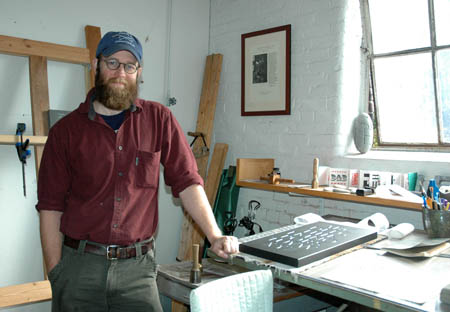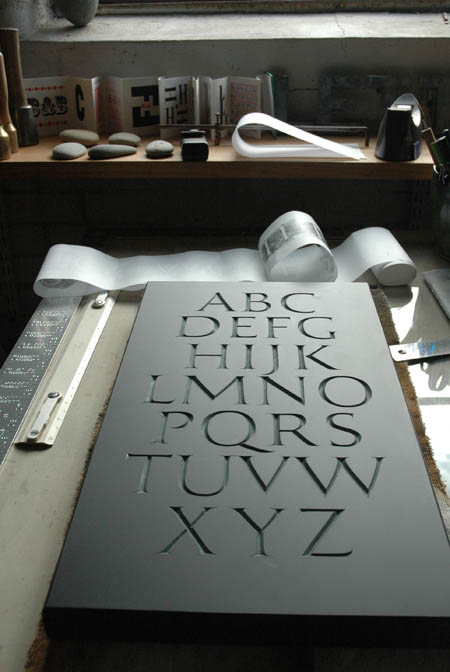

Jesse Marsolais has spent the last six years working alongside master letterpress printer John Kristensen at Firefly Press. In 2009, the two were awarded an MCC-funded Traditional Arts Apprenticeship to work specifically on Jesse learning to use and maintain 19th-century Linotype and Monotype typecasting machines.
This past June, Jesse also had the rare opportunity to apprentice under master carver Nick Benson at the John Stevens Shop in Newport, Rhode Island. The latter apprenticeship (letter carving in stone) was supported by a Southern New England Folk and Traditional Arts Apprenticeship, a unique program administered by Lynne Williamson which funds master artists and apprentices to work together across state lines in Connecticut, Massachusetts, and Rhode Island. The latter grant culminated in an open house this past June at the John Stevens Shop (JSS), which Jesse writes about in his own blog post.
Jesse’s nascent skills in letter carving are valued at the JSS, and he continutes to do occasional jobs for them when needed. If it weren’t for the fact that Jesse just opened his own printing and stone carving business in Millbury, MA, he might very well have been offered full time work in Newport.
Marsolais Press & Lettercarving, Inc. is located in a free-standing brick building which once housed a textile mill.

Jesse shares the space with blacksmith Derek Heidemann, who began learning his craft at age 14 at Old Sturbridge Village. “When I found out about the space I was really intrigued by the presence of a traditional blacksmith,” Jesse said. “Derek works for Old Sturbridge Village by day but then comes here and does his own things at night.”
Derek happened to be at the shop on the day I visited. His work at the forge gave the space a wonderful smell of burning coal and red hot iron, and the occasional clinking sounds of metal on metal.


Jesse offered this: “To be able to work in a space that has another traditional craftsman is really exciting and generative for me because it keeps the space alive with making. We’re vying for the same sensibility – for people that actually want the traditional process, the traditional level of quality.”
Jesse’s half of the work space is home to his newly acquired Chandler & Price Press, a 400-pound Miller saw, some type cases, a galley cabinet, his grandfather’s engineering drafting table, and a collection of typography and printing books. I ask him to talk about how the allied trades of letterpress printing and stone carving relate.
“For me, it seems like a really obvious bridge. [They are] two very related fields.” A self-proclaimed antiquarian, Jesse naturally has pursued learning more about the history and tradition of typography. “I think the more I researched and the farther back I went, the more I realized the debt modern typography owes to traditional Roman letterforms. Brush-driven letterforms. Obviously, these are two totally different methods of typographic or lettering reproduction but there is a continuum that’s very much alive in the over-arching tradition.”
There, lying on the drafting table was proof. A slate slab beautifully carved with a Roman alphabet – the letters chiseled in V-cut against the buttery smooth dark slate.


Nearby, was a large beach stone, looking to weigh some 50 pounds. Jesse had begun to design lettering of my father’s name for a memorial stone I’d commissioned. I asked him to talk about finding this particular stone. “Because I was able to learn a little bit about your father, I had some personal information at hand. . . Searching for a stone can be a fairly emotional and moving moment. . . I knew he was a man of science. It was important to me to find a stone that I thought I could carve.”

“This stone has a purplish hue and it has these beautiful bands of what looks like quartz and some darker stone. I look at this and I just think pressure and time. There’s a fluidity to it. There’s a flow inherent in the surface of the stone. So there’s this play of solid and liquid.”
Jesse’s shop will be easier to find once Jesse finishes his sign for the exterior of the building.

Two days later, I went to meet Jesse at the John Stevens Shop in Newport, Rhode Island. The shop has been in operation since 1705; walk inside and history speaks. Beautiful letterforms are everywhere you look. Jesse greeted me and showed me the piece he wass working on – an impression of a cancelled stamp, carved in white marble. I met Paul Russo, who was chipping away on a slate memorial, carving daffodils in relief. Nearby was a huge piece in progress for Yale University, acknowledging benefactors for their contributions to art, and a number of gravestones in various stages of completion.

Jesse shares with me that he couldn’t imagine better guys to work with and learn from. “They’ve been incredibly generous, not at all guarded with the secrets of the trade.”

As a folklorist working in the public sector, it is gratifying to help support a young man with skills and passion seek out mentors willing to pass on their knowledge in hand-wrought craftsmanship and receive priceless, one-on-one guidance. It is also affirming to see that a small investment of public money in the arts can play a part in growing small business developtment, while preserving age-old New England crafts.


